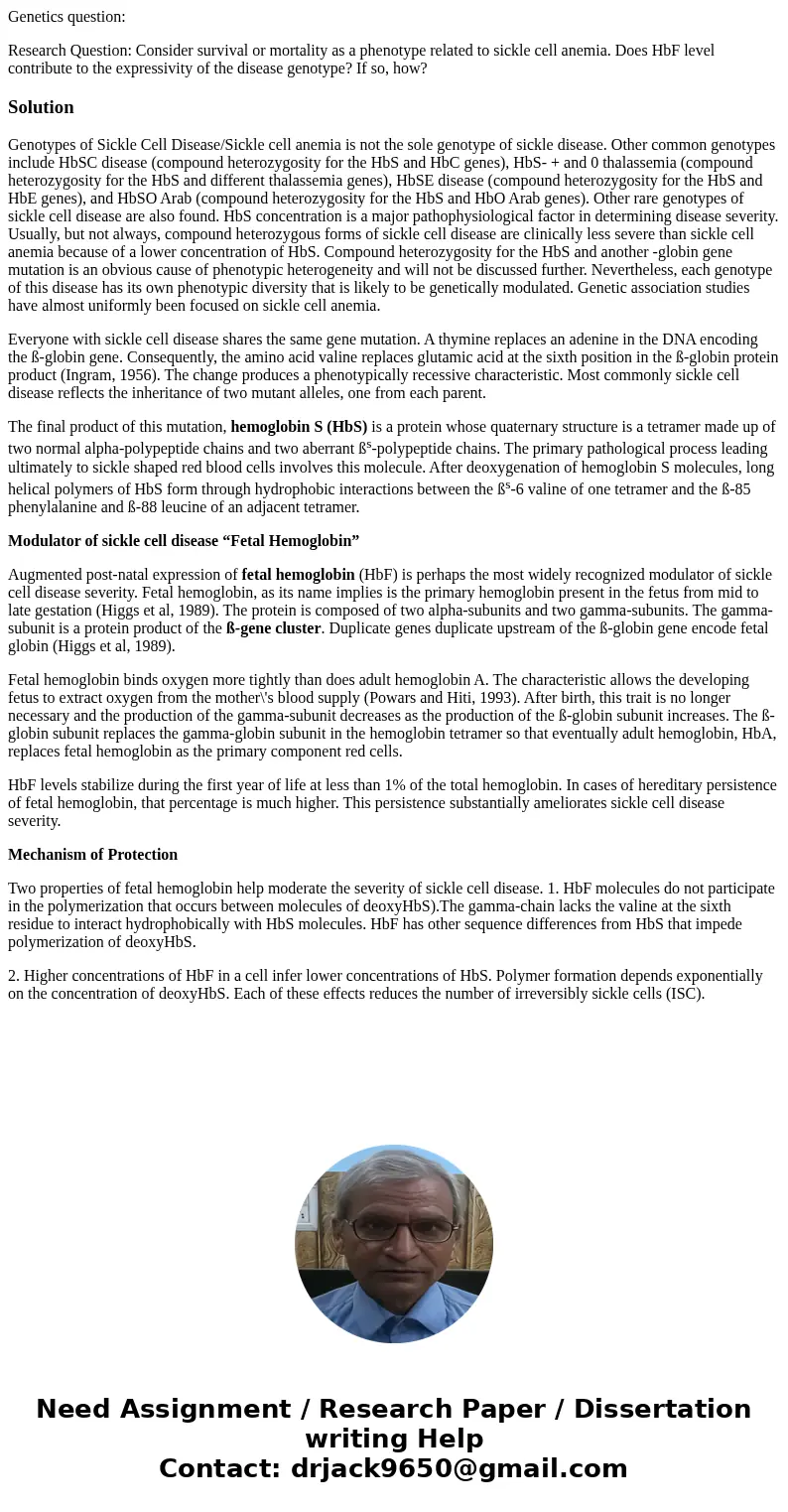Genetics question Research Question Consider survival or mor
Genetics question:
Research Question: Consider survival or mortality as a phenotype related to sickle cell anemia. Does HbF level contribute to the expressivity of the disease genotype? If so, how?Solution
Genotypes of Sickle Cell Disease/Sickle cell anemia is not the sole genotype of sickle disease. Other common genotypes include HbSC disease (compound heterozygosity for the HbS and HbC genes), HbS- + and 0 thalassemia (compound heterozygosity for the HbS and different thalassemia genes), HbSE disease (compound heterozygosity for the HbS and HbE genes), and HbSO Arab (compound heterozygosity for the HbS and HbO Arab genes). Other rare genotypes of sickle cell disease are also found. HbS concentration is a major pathophysiological factor in determining disease severity. Usually, but not always, compound heterozygous forms of sickle cell disease are clinically less severe than sickle cell anemia because of a lower concentration of HbS. Compound heterozygosity for the HbS and another -globin gene mutation is an obvious cause of phenotypic heterogeneity and will not be discussed further. Nevertheless, each genotype of this disease has its own phenotypic diversity that is likely to be genetically modulated. Genetic association studies have almost uniformly been focused on sickle cell anemia.
Everyone with sickle cell disease shares the same gene mutation. A thymine replaces an adenine in the DNA encoding the ß-globin gene. Consequently, the amino acid valine replaces glutamic acid at the sixth position in the ß-globin protein product (Ingram, 1956). The change produces a phenotypically recessive characteristic. Most commonly sickle cell disease reflects the inheritance of two mutant alleles, one from each parent.
The final product of this mutation, hemoglobin S (HbS) is a protein whose quaternary structure is a tetramer made up of two normal alpha-polypeptide chains and two aberrant ßs-polypeptide chains. The primary pathological process leading ultimately to sickle shaped red blood cells involves this molecule. After deoxygenation of hemoglobin S molecules, long helical polymers of HbS form through hydrophobic interactions between the ßs-6 valine of one tetramer and the ß-85 phenylalanine and ß-88 leucine of an adjacent tetramer.
Modulator of sickle cell disease “Fetal Hemoglobin”
Augmented post-natal expression of fetal hemoglobin (HbF) is perhaps the most widely recognized modulator of sickle cell disease severity. Fetal hemoglobin, as its name implies is the primary hemoglobin present in the fetus from mid to late gestation (Higgs et al, 1989). The protein is composed of two alpha-subunits and two gamma-subunits. The gamma-subunit is a protein product of the ß-gene cluster. Duplicate genes duplicate upstream of the ß-globin gene encode fetal globin (Higgs et al, 1989).
Fetal hemoglobin binds oxygen more tightly than does adult hemoglobin A. The characteristic allows the developing fetus to extract oxygen from the mother\'s blood supply (Powars and Hiti, 1993). After birth, this trait is no longer necessary and the production of the gamma-subunit decreases as the production of the ß-globin subunit increases. The ß-globin subunit replaces the gamma-globin subunit in the hemoglobin tetramer so that eventually adult hemoglobin, HbA, replaces fetal hemoglobin as the primary component red cells.
HbF levels stabilize during the first year of life at less than 1% of the total hemoglobin. In cases of hereditary persistence of fetal hemoglobin, that percentage is much higher. This persistence substantially ameliorates sickle cell disease severity.
Mechanism of Protection
Two properties of fetal hemoglobin help moderate the severity of sickle cell disease. 1. HbF molecules do not participate in the polymerization that occurs between molecules of deoxyHbS).The gamma-chain lacks the valine at the sixth residue to interact hydrophobically with HbS molecules. HbF has other sequence differences from HbS that impede polymerization of deoxyHbS.
2. Higher concentrations of HbF in a cell infer lower concentrations of HbS. Polymer formation depends exponentially on the concentration of deoxyHbS. Each of these effects reduces the number of irreversibly sickle cells (ISC).

 Homework Sourse
Homework Sourse